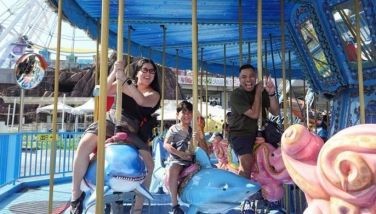River of academic tradition

February 27, 2006 | 12:00am
 Launched last week in Loyola Heights was a significant collection of interviews of past teachers, conducted by current teachers whom the first set mentored at some point in time.
Launched last week in Loyola Heights was a significant collection of interviews of past teachers, conducted by current teachers whom the first set mentored at some point in time.
The book is University Traditions: The Humanities Interviews, edited and designed by Ramon C. Sunico and published by the Office for Mission and Identity and Organizational Development (OMIOD) of Ateneo de Manila University.
The interviewees are Fr. Catalino G. Arevalo SJ; Fr. Asandas D. Balchand SJ; Fr. Miguel A. Bernad SJ; Dr. Manuel B. Dy Jr.; Fr. Roque J. Ferriols SJ; Dr. Leovino Ma. Garcia; Dr. Edna Z. Manlapaz; Dr. Soledad S. Reyes; Dr. Ramon C. Reyes; Fr. Joseph I. Roche SJ; Ms. Concepcion L. Rosales; and Dr. Benilda S. Santos.
In his preface, AdMU president Fr. Bienvenido F. Nebres SJ, refers to these men and women as "the key culture-bearers of the Ateneo de Manila." Additionally, they are also "the founders and giants and the ‘main streams’ of that river called Ateneo history."
Their former students and protégés who followed in the noble teaching profession, specifically in the Humanities, serve as the interviewers, with a few doing more than one interview: Eduardo Jose E. Calasanz; Danton R. Remoto; Joseph T. Salazar; DM Reyes; Karen B. Cardenas; Dr. Leovino Ma. Garcia (in a double role; after all, he is the current Humanities dean); Dr. Roberto M. Paterno; Dr. Victoria B. Parco; and Dr. Ma. Christina A. Astorga.
Dr. Garcia’s foreword characterizes the interviews, indeed the book, as being "about narratives or life stories," where an earlier generation of faculty members "recount their life stories of working and teaching," and how, "In interpreting what it means to become human together, they help future generations of teachers and students know who they are, what they have to do and where they are going."
Anthologies featuring many voices have now justifiably come into favor for assembling the little histories and back stories, the streams of narrative, that together become the synergistic, grand river of history.
This book does that, commendably, while offering an instructive, inspirational roadmap to all teachers, not just those in the Humanities or in the Ateneo.
Fr. Miguel Bernad, for instance, while recalling the early days of the Ateneo in both Intramuros and Padre Faura, fashions his retelling with an encompassing memory – from his own early schooling to becoming a novice thence doing his regency at the modest Padre Faura campus, where he spent "the three happiest years of my life."
His narrative then spans what he identifies as the "very intense Ateneo spirit" in those days, to the nobility of Ateneo boys teaching catechism in slum areas, on their own, during the Japanese Occupation when their school was closed, the Sodality meetings, the move to Loyola Heights, the study of Latin and Greek, regarding which the good father-teacher offers an insight.
Recalling Supreme Court Justice Norberto Romualdez giving a lecture on the psychology of the Filipino, Fr. Bernad offers:
"He brought the idea, which I took for granted, that Philippine languages are passive. Now, the idea of active and passive is from Latin. For example, an American would say, ‘I killed Pedro.’ The Filipino would say, ‘Pedro was killed by me.’ Tagalog is a passive language. It also means a different way of thinking. The attitude, the set of mind, which allows you to perceive that difference, can be obtained from knowledge of a very logical language like Latin or Greek. Only a person who knew Latin like Norberto Romualdez could have given that lecture."
For her part, Dr. Edna Manlapaz compares the earlier years, in the ’70s, when "You were almost certain that all of (the students) had gone through the tedious but valuable discipline of diagramming sentences" to the university’s eventual effort to establish "a wider cross-section of students" by opening its gates to "financially disabled" students who were less skilled in the English language. This gave birth to the euphemistically termed "track A (for Remedial English) and track-B (for Advanced English) sections, while maintaining a "homogeneous grouping" for freshmen.
Dr. Sol Reyes, who initially conceptualized this book, pays tribute to the years when she was "molded" by such outstanding, nationalistic mentors as Bienvenido Lumbera and Rolando Tinio, who both stressed the value of cultural research, at a time when "The Jesuits were very busy fending off criticism coming from the left. Remember: this was the time of Alfrredo Navarro Salanga’s ‘Down From the Hill,’ an article that made a lot of teachers and students think of Ateneo’s role in a country."
She recalls further, of the time of the First Quarter Storm: "The Ateneo was about to explode. It was a tumultuous period, and the Ateneo became a politicized university…. Students were attempting to make connections between these (political) events and the theories and ideas they were being taught. I was very conscious of the need for real nationalism."
Just as valuable is the extended foreword written by the book’s editor and designer, "RayVi" Sunico, who takes us on a quick, vivid tour of the background of Jesuit education, from the pre-paper teaching mode to what eventually developed as preparation for reading assignments.
"Before students engaged the texts themselves, teachers would spend time describing these texts by way of dictated synopses, brief biographies and surveys of related commentaries. This was pre-reading, prelection, and it led students by the hand to the very edges of the books themselves."
He also leads us by the hand through the growth of the Ateneo, from the "original Escuela Municipal" of 1859, to the "Ateneo Municipal de Manila six years later," and after four decades, the replacement of Spanish Jesuits by their "American confreres, mostly from the Maryland-New York province. It would be these Jesuits who would instruct and inspire the golden generation of Filipino Jesuit teachers and Ateneo students."
Many other parts of this book can teach teachers and students alike. In these turbulent times, the river that is the Ateneo tradition of excellence can only be most welcome – as calm waters of rationality and idealism, amid so much roiling passion.
BrandSpace Articles
<
>




















